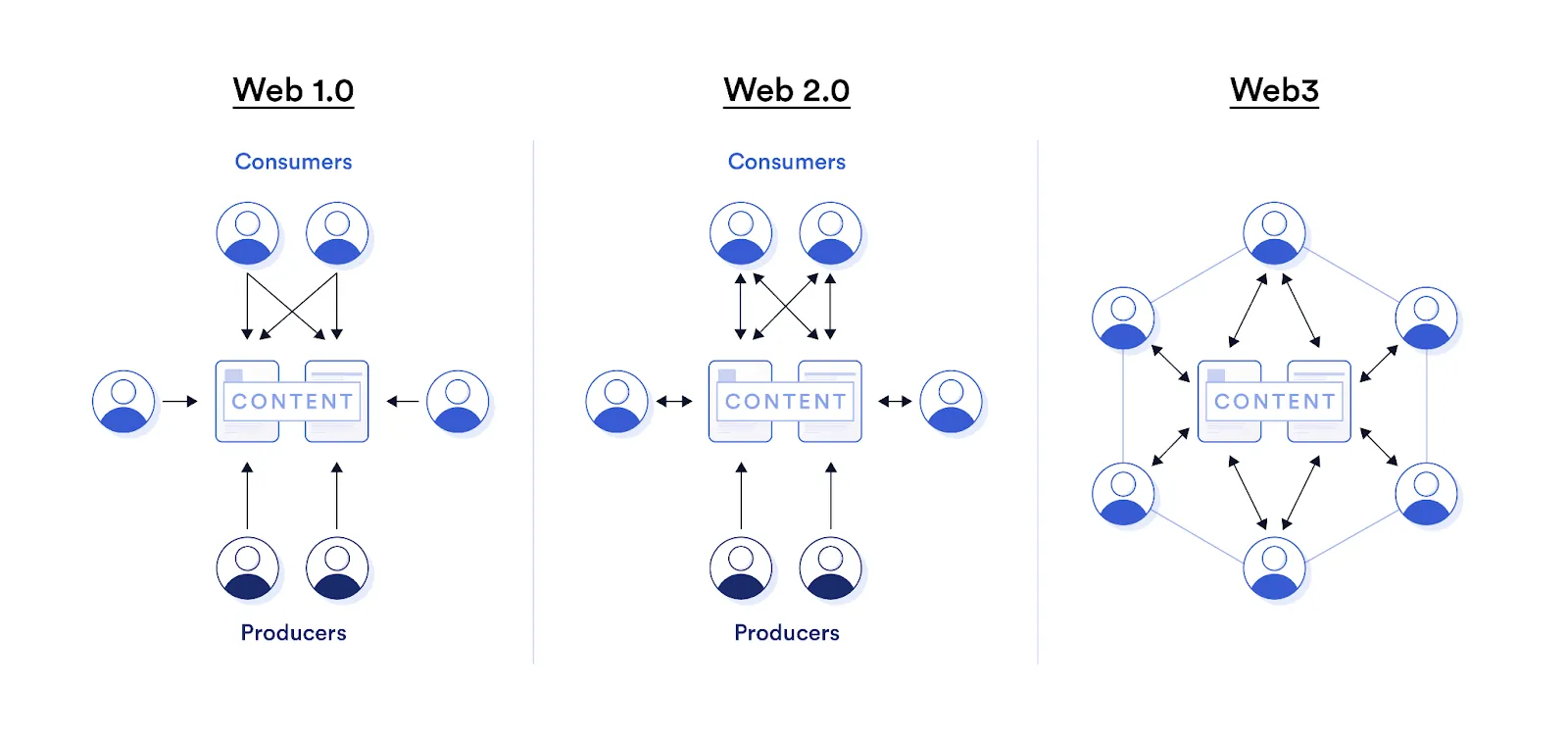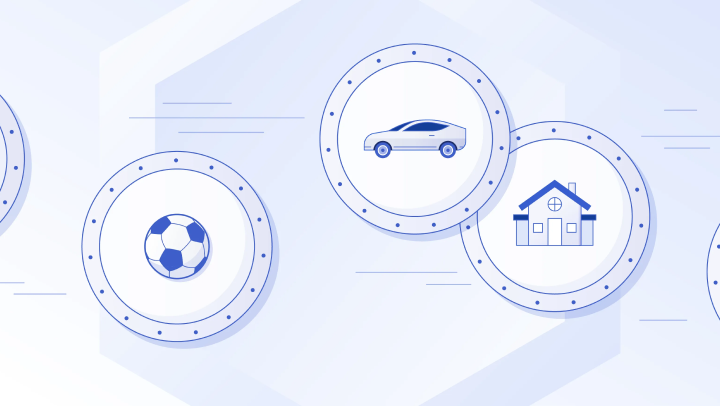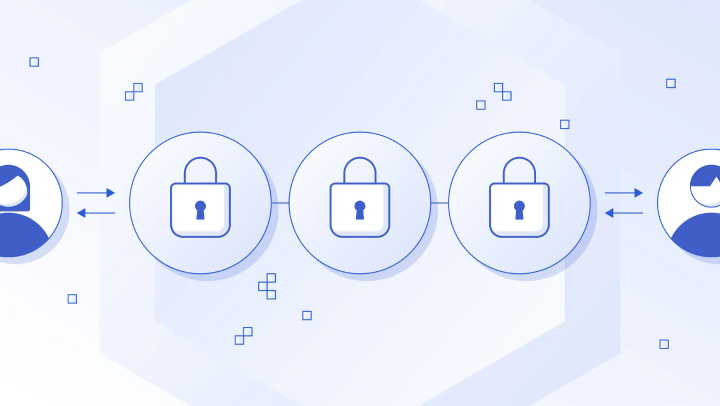What is Web3?
Web3 is a new evolution of the Internet based around the principles of decentralization. Web3 combines the rich and interactive digital experiences that exist today with infrastructure that offers users ownership and cryptographic guarantees.
Web3 has recently burst into the mainstream consciousness, with industry leaders across the traditional tech sector and blockchain ecosystem weighing in with a wide range of perspectives on the past and future of the Internet.
Before we dive in, a brief history of the term.
The term “Web 3.0” was first used during the dotcom era by HTTP pioneer Tim Berners-Lee to describe an integrated communication framework in which Internet data is machine-readable across different applications and systems—a concept he also referred to as the Semantic Web.
Later, in his 2014 blog post DApps: What Web 3.0 Looks Like, Ethereum Co-founder Gavin Wood repurposed Berners-Lee’s expression, using it to refer to the ability of blockchain technology to define a “fundamentally different model for the interactions between parties” based on “a zero-trust interaction system.”
Wood’s writing focused not on cryptocurrencies but on protocols and technologies, such as consensus engines and cryptography, that could facilitate a stronger social contract across the web. He later described the aim of Web3 as “Less trust, more truth.”
Now, the term is the subject of much debate, with both the tech giants of today and the vanguard of the blockchain industry continuing to reckon with Web3’s core propositions and protocols, and its implications for the trust models of the future.
In this deep dive, we’ll define Web3 in relation to earlier iterations of the Internet, walk through the key technologies of the Web3 stack, and explore the current and future state of the Web3 landscape.
A note on terminology: We’ll use the term “Web3” as distinct from “Web 3.0”, which is often associated with Berners-Lee’s vision of the Semantic Web.
The Evolution of the Internet: From Web 1.0 to Web 2.0 to Web3
To truly grasp the meaning of Web3, it’s important to understand the history of the Internet and how Web3 differs from the versions of the web that preceded it.
Web 1.0 (1994-2004)
Web 1.0 was the first iteration of the Internet we’re familiar with today, emerging in 1994 and ending around 2004 with the rise of social media giants like Twitter and Facebook. While the general public came to learn about the Web 1.0 Internet around 1994, Web 1.0 actually started as a U.S. government program called ARPANET, or Advanced Research Projects Agency Network, in 1968. ARPANET began as a small network of military contractors and university professors who exchanged data with one another.

The Web 1.0 Internet was mostly a collection of static HTML pages and afforded users limited ability to interact with each other. Although Internet gateways such as America Online (AOL) and discussion forums such as Usenet permitted private chat and discussion boards, for most the Internet remained a space where few interactions or financial transactions took place.

Where interactions and financial transactions did take place, they were limited in scope because there was a lack of secure infrastructure for transferring money. One of the most innovative Web 1.0 companies in this respect was Pizza Hut, which in 1995 created an order form for its customers that they could use to place an order and pay in cash once this order was delivered.

Despite America Online’s claim in a 1995 commercial that users could order flowers for their mom, buy tickets to a sports game, or write a research report on dinosaurs with AOL, exchanging money online required speaking with an operator since financial transactions were generally unsafe and had limited encryption.
Web 2.0 (2004-The Present)
The web evolved around 2004 as user demand for social interactions, music, video sharing, and financial transactions grew dramatically due to improved Internet speed, fiber optic infrastructure, and search engine improvements.

This demand for greater interactivity gave rise to many of today’s Internet institutions and companies. Social media platforms like Facebook, MySpace, and Twitter facilitated social interaction; data-sharing applications such as Napster met the demand for online music and video; Google provided an effective means for users to navigate the huge quantity of online information. Traditional institutions such as Bank of America met the demand for financial interactions and electronic fund transfers, enabled by new encryption standards such as 256-bit AES.
This new, more interactive Internet improved users’ experiences of the web tremendously by adding new functionality. But it also presented a tradeoff that continues to define our online lives to this day: To benefit from these new functionalities and interactions, users have to delegate a large quantity of information and responsibility to siloed third-party platforms, granting these centralized entities a considerable amount of power and influence in terms of data and content ownership.
This is, for the most part, how the Internet operates up until the present day. In the United States alone, Google, YouTube, Facebook, and Amazon combined received 23.56 billion visits in October 2021—roughly double the traffic of websites ranked 5-20.
Web3 (2008-The Future)
In 2008, Satoshi Nakamoto published the Bitcoin whitepaper, which outlined the fundamentals of blockchain technology and a peer-to-peer digital currency, setting a course to change the Web 2.0 paradigm. Bitcoin transformed how we think about digital transactions and provided the first secure means of exchanging money over the Internet that didn’t require a trusted third party. “What is needed,” Satoshi wrote, “is an electronic payment system based on cryptographic proof instead of trust.”
It was not until the invention of smart contracts that a decentralized model of the Internet truly came into focus. If Bitcoin enabled secure peer-to-peer payments and smart contracts could expand this idea of programmable agreements to more advanced use cases—insurance, gaming, identity management, supply chains—how would the nature of web experience and digital interaction evolve? By enabling users to directly and securely transact with one another, smart contracts created a fresh vision for an Internet that is fair, transparent, and powered by cryptographic truth.
Gavin Wood described this reimagined web—Web3—as a “Secure Social Operating System.”
Put simply, Web3 is a decentralized vision of the Internet that aspires to create an entirely new system of contracts and change the way that individuals and institutions reach agreements. Web3 brings back the decentralized architecture of Web 1.0, the first version of the Internet, which was replete with user-hosted blogs and RSS feeds, and combines it with the rich, interactive experience of Web 2.0 web applications like social media platforms to provide a digital ecosystem where data is user-owned and transactions are backed by cryptographic guarantees. Rather than having to trust brand-based paper promises, users can rely on deterministic software logic to execute agreements exactly as programmed.

The Core Elements of Web3: Blockchains, Cryptocurrency, Smart Contracts, and Oracles
Powering the Web3 model is a growing stack of decentralized technologies, such as blockchains, smart contracts, oracles, crypto wallets, storage networks, and more. Below, we walk through some of the critical layers and componentry of the Web3 technology stack.
Blockchains
A blockchain is a highly secure and decentralized network that allows people to store data, exchange value, and record transaction activity in a shared ledger that is not controlled by any central authority. Blockchain networks serve as the backbone of Web3, providing secure execution environments that allow for the creation, distribution, and trading of cryptocurrencies, as well as the development of programmable smart contracts. Blockchains are the settlement layer of Web3.
Cryptocurrency
Cryptocurrencies are digital tokens that leverage the decentralized and tamper-proof environments of blockchain networks to facilitate highly secure transactions. They are the native currencies of Web3 decentralized applications (dApps) and can also be used to pay for Web3 services and participate in Web3 governance.
Before blockchain technology, tokens were units of value that could be purchased and exchanged to pay for specific products and/or services, such as tokens for highway tolls or amusement park rides and games. In these earlier applications, tokens were useful to service providers because they allowed customers to pay upfront for services that they would consume in the future and because they facilitated transactions where exact change was required.
Tokens in Web3 applications are also units of value issued to Web3 content creators, but these units of value are digital, programmable, and have functions beyond exchange. In Web3, a token might be held as an investment in a protocol, project, or blockchain. It might have utility for that project or protocol—for paying for a service or insuring a service, for example. It might also provide a gateway to participation in the governance of the protocol or project.
Smart Contracts and Decentralized Applications (dApps)
Smart contracts are tamper-proof programs on blockchains that facilitate automatic transactions by using conditional software logic such as, “if x is true, then execute y.” Programmable smart contracts enable the creation of decentralized applications, or dApps, the cryptoeconomic protocols that bring Web3 to life and put it in the hands of users.
dApps are different from the applications (apps) that we are familiar with in the Web 2.0 world and the static HTML pages from the Web 1.0 world because they are not maintained by any single individual or organization but rather powered by the decentralized infrastructure of blockchain networks. These seemingly simple, decentralized programs can be used to create complex, automated systems such as peer-to-peer financial services (DeFi), data-driven insurance products, play-to-earn online games, and more.
Oracles
To realize their full potential, smart contracts need to access and interact with data and systems outside of blockchain networks. Oracles are the entities that connect blockchains to real-world data and existing systems, and provide critical infrastructure for establishing a unified, interoperable Web3 ecosystem.
Chainlink oracle networks not only feed financial market data on-chain to power DeFi applications, but they also provide a wide range of secure off-chain computations such as verifiable randomness and decentralized execution to enable dynamic NFTs and highly automated dApps. Moreover, with the development of the Cross-Chain Interoperability Protocol (CCIP), oracle networks will help enable the fast-growing ecosystem of different blockchains and layer-2 scaling solutions to securely communicate with one another.
Oracles have emerged as an expansive layer of the Web3 stack, providing off-chain data and services to facilitate smart contract innovation, and cross-chain interoperability to help ensure seamless connectivity between different on-chain environments. Chainlink’s oracle infrastructure is also the gateway to Web3 for Web 2.0 backends, serving as an abstraction layer for traditional systems to interact with any private or public blockchain. Ultimately, oracles are the infrastructure that extends the power of decentralized computation and cryptographic guarantees to existing systems, bridging Web 2.0 and Web3.

The renewed interest in NFTs has led to a Cambrian explosion of unique applications that leverage the property of non-fungibility in innovative ways, often with the goal of increasing efficiency in the transfer of asset ownership and reducing the need for intermediaries who siphon value away from creators and marketplaces. However, NFTs are still largely in their infancy, meaning there is a vast amount of opportunity for growth from innovative developers, creative artists, and traditional institutions wanting to bring distinct assets on-chain.
Web3 Applications
Web3 combines decentralization and interactivity to create a new model for the Internet where users can interact directly, without intermediaries. dApps allow users to access permissionless financial tools, trade cryptocurrencies in a peer-to-peer manner, receive parametric insurance payouts, buy and sell verifiably owned digital art through NFTs, play value-generating games, and a whole host of other activities—all without the intervention of a central arbiter.
With this new structure, the proponents of Web3 hope to create a fairer, more open version of the Internet where parties can interact and transact directly. Currently, Web3 applications that leverage the three foundational technologies—blockchains, smart contracts, and decentralized oracle networks—are already unlocking use cases that are redefining sectors as diverse as real estate, education, finance, gaming, and healthcare, and are set to have a transformational impact well beyond these domains.
The technologies that comprise Web3 enable individuals to create and participate in financial protocols that offer unprecedented access, security, and transparency—a new economic landscape that is now widely known as decentralized finance (DeFi).
Unlike traditional financial services, DeFi protocols leverage the decentralized infrastructure of blockchains and the secure inputs of oracle networks to help users directly transact with one another in transparent and tamper-proof on-chain markets. Decentralized money markets such as Aave—which now secures over $12B in smart contract value using Chainlink oracles—operate in a non-custodial manner and enable users to lend and borrow funds peer-to-peer. Money markets are a key mechanism for supporting a healthy economy. By decentralizing control and leveraging predefined smart contract logic, on-chain money markets help increase economic access, reduce single points of failure, and mitigate system risk and fractional reserve practices.
One great DeFi innovation is its composable architecture, which empowers developers to combine open-source protocols into more sophisticated financial instruments, such as no-loss savings games that use overcollateralized loan protocols, decentralized stablecoins, and interest-bearing tokens that put idle capital to work and unlock liquidity.
While the novel financial applications offered by DeFi are currently one of the most prominent aspects of Web3, the Web3 model extends far beyond financial transactions, encompassing every area of the Internet, from entertainment and social media to browser software.
NFTs, Gaming, and the Metaverse
NFTs, blockchain gaming, and the metaverse are currently emerging as key pillars of the Web3 ecosystem. NFTs offer verifiable ownership of digital assets, allowing digital goods to have a functional level of uniqueness similar to that of items in the real world. With NFTs, one digital item can now be differentiated from another even if they present the same way, similar to how two copies of the same book can be differentiated through their unique markings and evidence of specific wear-and-tear.
This has massive implications for digital art, metaverse applications, and video games. Currently, NFT projects such as Bored Ape Yacht Club (BAYC) are popularizing NFTs and digital art, and blockchain games such as Axie Infinity are spearheading a paradigm shift in player economics in gaming. Underpinning this foundational transformation are blockchains, which operate as the underlying settlement layer, NFT smart contracts, which enable verifiable ownership of digital items, and decentralized oracles, which provide key services such as verifiable randomness, smart contract automation, off-chain data, and more.
Parametric Insurance
One exciting use case emerging within the blockchain industry is decentralized parametric insurance. Blockchain insurance projects such as Arbol and Etherisc are currently implementing novel implementations of frictionless and automated crop insurance, flight insurance, and more through a combination of smart contracts and off-chain data inputs facilitated by Chainlink Data Feeds. Let’s walk through a quick example.
Imagine a farmer requires more than 20 inches of rain in a season for an adequate crop harvest. The farmer wants to hedge against the risk of a bad harvest through insurance. Normally, he would have to go through a lengthy process to receive funds and need to rely on a centralized insurance provider to verify the amount of rainfall.
However, in Web3, anyone in the world can permissionlessly take on a policy with just an Internet connection. With the blockchain-based crop insurance provided by Arbol, the insurance cost and payout terms are automatically determined based on pre-defined parameters, and payment is automated through an insurance smart contract based on weather data provided Chainlink. The insurance process becomes quick and painless, with a simple binary that determines whether the farmer receives insurance funds. Did an IoT sensor record less than 20 inches of rain that season? If yes, pay the farmer immediately. If no, don’t pay the farmer.
This model has the ability to be expanded to areas such as shipping and fire insurance, with blockchain-based parametric flight insurance already in operation.
What’s Next for Web3
In his recent Future of Chainlink presentation, Chainlink Co-founder Sergey Nazarov explained the emerging megatrends of the Web3 ecosystem that have recently pierced the mainstream: “What you really see with the implementation of cryptographic guarantees in the Web3 world is a very specific set of applications, and some of these applications are called DeFi, some of them are called NFTs, some of them are called tokenized ownership, but these are the very early examples of cryptographic guarantees making their way into people’s and industries’ daily operations.”

Web3—a term that has become shorthand for a reimagined Internet experience powered by decentralized technologies—is already transforming how we interact online, from how we invest and exchange to how we play and express ourselves artistically. More and more users and institutions across the globe are waking up to the power of zero-trust interactions and cryptographically-backed agreements. While Web3 is still in its early stages, it has the potential to realize the ideals of hardwired transparency, reliability, and expediency the Internet was built to fulfill. “At the end of the day,” Nazarov noted, “as Web3 approaches the speed, the efficiency, and the low cost of web systems, it has a guarantee that no Web 2.0 system can ever have, which is the trust minimization cryptographic guarantee.”
Start building with Chainlink today by visiting the developer documentation, joining the technical discussion on Discord, and/or reaching out to an expert.To learn more about Chainlink, visit the Chainlink website and follow the official Chainlink Twitter to keep up with the latest Chainlink news and announcements.













